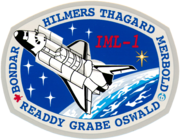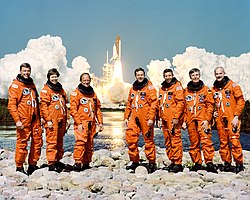STS-42
| Mission emblem | |||
|---|---|---|---|

|
|||
| Mission dates | |||
| Mission: | STS-42 | ||
| COSPAR-ID : | 1992-002A | ||
| Crew: | 7th | ||
| Begin: | January 22, 1992, 14:52:33 UTC | ||
| Starting place: | Kennedy Space Center , LC-39A | ||
| Landing: | January 30, 1992, 16:07:17 UTC | ||
| Landing place: | Edwards Air Force Base , Runway 22 | ||
| Flight duration: | 8d 1h 14m 44s | ||
| Earth orbits: | 129 | ||
| Rotation time : | 90.5 min | ||
| Orbit inclination : | 56.9 ° | ||
| Apogee : | 305 km | ||
| Perigee : | 293 km | ||
| Covered track: | 4.6 million km | ||
| Payload: | Spacelab | ||
| Team photo | |||
 v. l. No. Stephen Oswald, Roberta Bondar, Norman Thagard, Ronald Grabe, David Hilmers, Ulf Merbold, William Readdy |
|||
| ◄ Before / After ► | |||
|
|||
STS-42 ( english S pace T ransportation S ystem) is a mission designation for the US Space Shuttle Discovery (OV-103) of NASA . The launch took place on January 22, 1992. It was the 45th space shuttle mission and the 14th flight of the space shuttle Discovery.
team
Main team
-
Ronald Grabe (3rd space flight), commander

-
Stephen Oswald (1st spaceflight), pilot

-
Norman Thagard (4th spaceflight), mission specialist

-
David Hilmers (4th space flight), mission specialist

-
William Readdy (1st spaceflight), mission specialist

-
Roberta Bondar (1st Spaceflight), Payload Specialist ( CSA ) Canada

-
Ulf Merbold (2nd space flight), Payload Specialist ( ESA ) Germany

Originally, Mary Cleave provided as a mission specialist. Since she left NASA for personal reasons, she was replaced by Sonny Carter in January 1990 . Carter was killed in a plane crash in April 1991. David Hilmers took over his duties.
replacement
-
Ken Money (CSA) for Bondar

-
Roger Crouch for Merbold

Mission overview
The STS-42 mission began with a problem-free start on January 22, 1992. The microgravity laboratory-1 (IML-1) was located in the space shuttle's payload bay . This Spacelab- based module contained experiments to explore the complex effects of weightlessness on living organisms and other materials. In order to be able to carry out experiments around the clock, the crew worked in shifts. Grabe, Oswald, Thagard and Bondar made up the blue team, while Hilmers, Readdy and Merbold made up the red team.
In order to achieve the lowest possible disturbance of weightlessness through orbit maneuvers, a gravitational stabilized position, with the tail towards the earth, was adopted for the majority of the flight duration. The advantages of microgravity should be investigated in 13 material science and 29 biological experiments.
The material experiments mainly dealt with the cultivation of large and pure crystals ( protein crystals , crystallization of salt solutions to investigate emerging anomalies and cracks, vapor crystallization of mercury iodide, cultivation of organic crystals as possible superconductors). Biomedical examinations were partly carried out under microgravity and in four small centrifuges that simulated different gravitational forces. However, the 480 fruit flies died within three days due to toxic contamination in the food. The experiments with bacteria, crab eggs and lentil seedlings were more successful. Further investigations concerned space traveler's disease (vestibular sledges), the loss of effectiveness of antibiotics , plant growth and sensitivity to light, and the effects of cosmic radiation on living organisms. Automatic investigations in 10 GAS containers (Get Away Special), IMAX recordings for the film "Adventure Space Travel" and several experiments in the middle deck of the shuttle completed the research program.
Technical problems led to the flight being extended by one day in order to fulfill the work plan as much as possible. Therefore, the landing took place on January 30th at Edwards Air Force Base. Two weeks later the Discovery was flown back to KSC.
See also
Web links
- NASA Mission overview (English)
- Video summary with comments of the crew (English)
- STS-42 in the Encyclopedia Astronautica (English)
